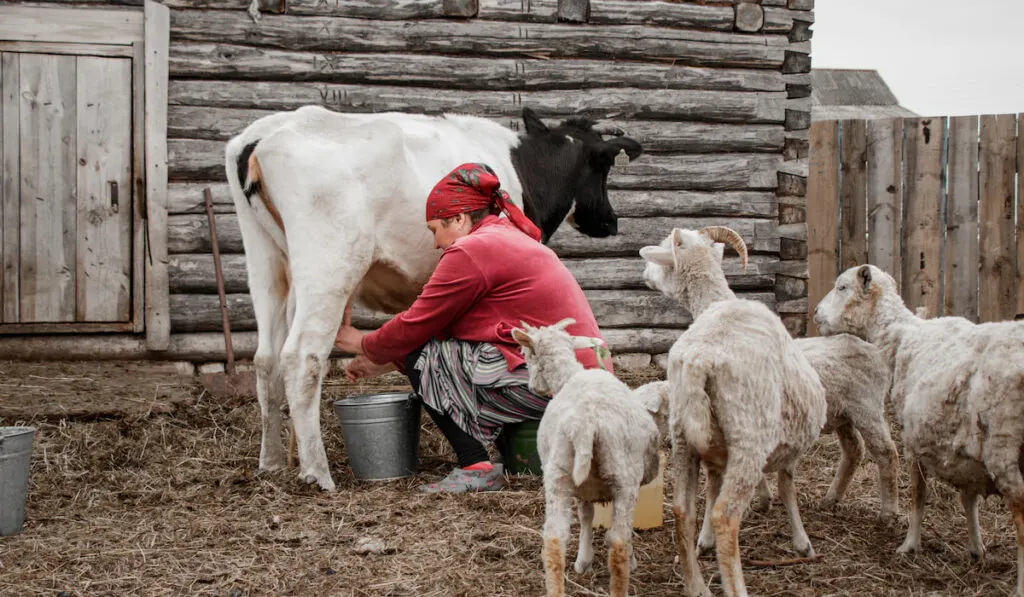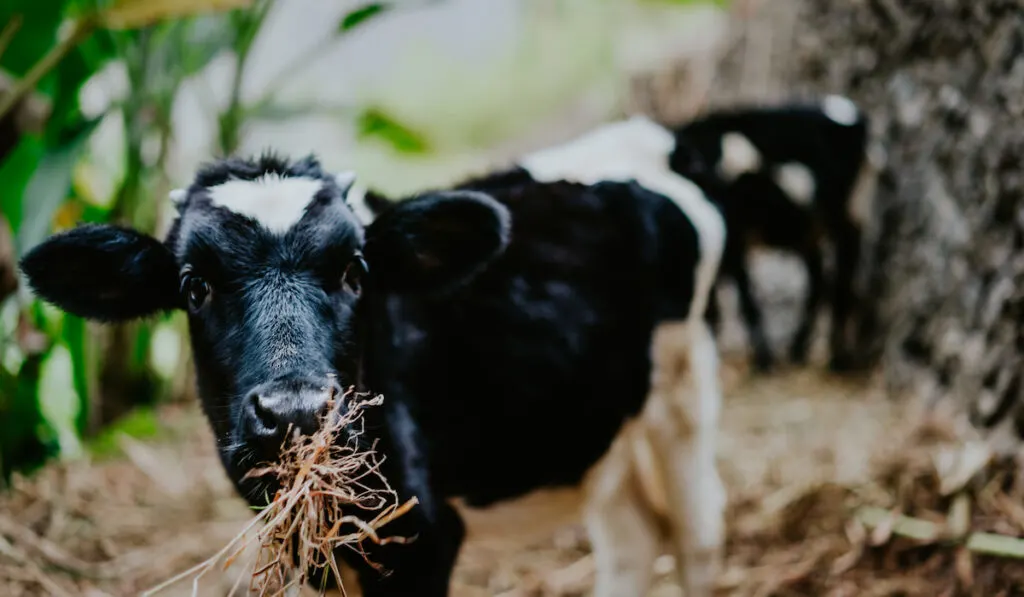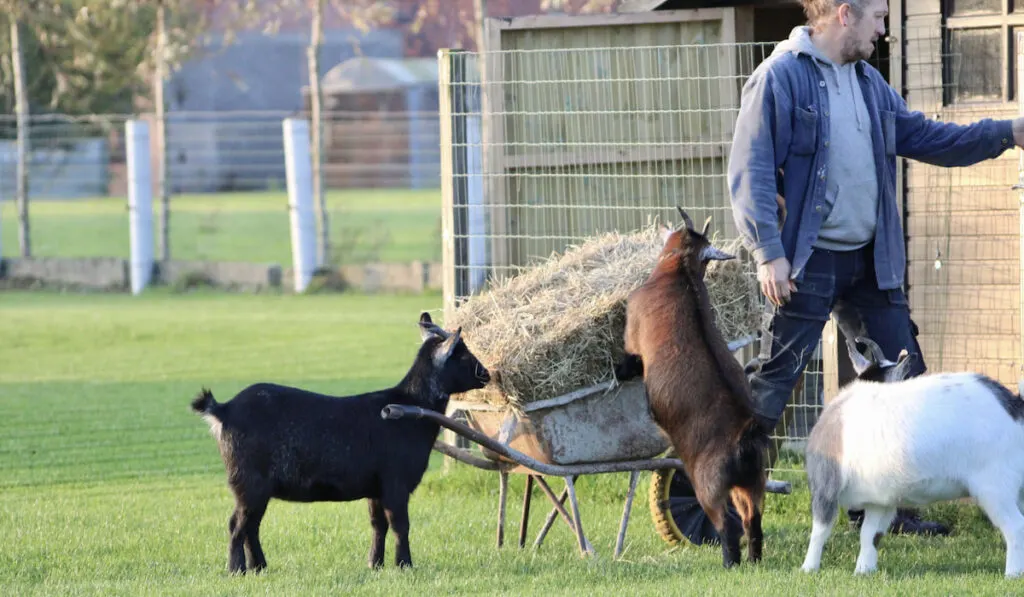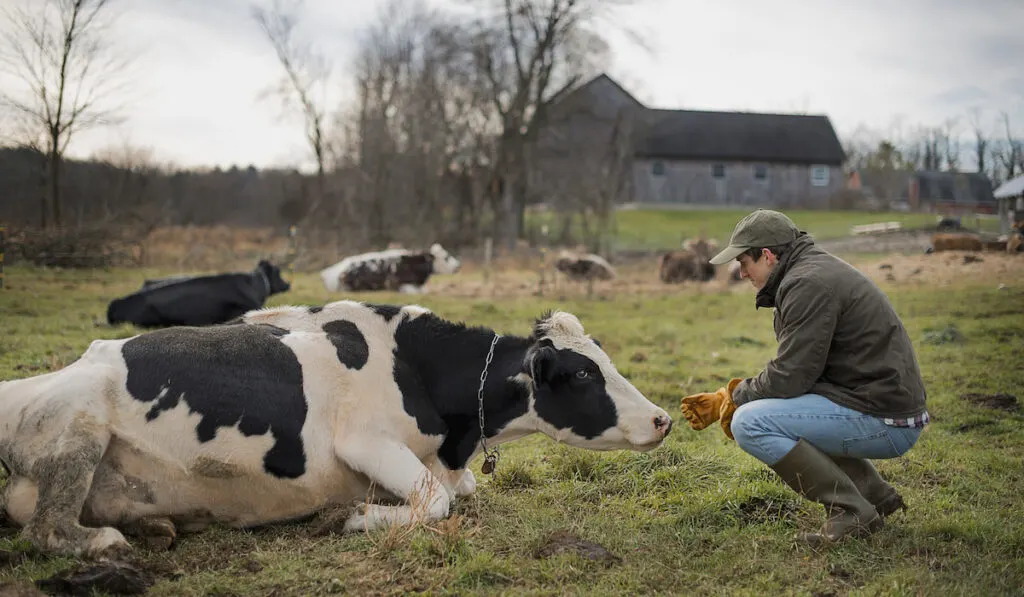Do you plan to raise both cows and goats together? It is easy to raise both cows and goats. But have you wondered if you need to make special considerations to raise them together? It’s important to ensure that your animals all have a safe place to live, eat, and rest.
Do cows get along with goats?
With proper care and less competition, cows and goats get along and can live side by side happy and healthy. You do not have to worry about cows and goats fighting each other in the pen. In fact, might become friends with time.

Table of Contents
Caring for Cows and Goats Together
If cows and goals get along well, do you need to worry about anything else when raising both animals? Are there diseases that can be transmitted from cows to goats (or vice versa)?
Let’s take a look at the similarities between cows and goats and the factors that can come into play when keeping them together.
Similarities Between Cows and Goats
Asides size and other notable physical differences, cows and goats are very similar when it comes to their care.
Digestion
Cows and goats are not just herbivores; they are ruminant animals. Herbivorous animals are animals that eat grass, leaves, fruits, and other plant products.
Ruminant animals are animals that possess an organ called the rumen.
There are many microbes in the rumen of cows and goats that help break down food particles into digestible materials.
Many animals cannot eat and digest food rich in cellulose or dietary fiber, but cows and goats can easily break down cellulose with the help of the microbes in their rumen.
Some of the microbes in the rumen are digested along with food particles, so cows and goats have an extra source of digestive help when eating their daily feed.
Diet
Cows and goats have similar dietary needs and can often share feed. Examples of healthy feed that both cows and goats eat:

- Grass
- Fruits
- Pellets
- Plant leaves
- Treats
You should prevent the animals from eating leaves of plants in the nightshade family (Solanaceae) such as tomatoes, potatoes, and tobacco because plants in the nightshade family have phytotoxins in their leaves.
People who raise birds with cows or goats are advised to keep bird feed away from goats and cows since it contains animal products.
Is there competition between both animals when feeding? Not at all. Cows graze while most goats browse when feeding.
Browsing in herbivorous feeding is when animals like goats look for the leaves of taller plants like trees or shrubs. Cows graze, meaning that they prefer eating grass and other lower plants.
Goats can eat grass but prefer to browse. This means that in a pasture, there will be little competition between cows and goats.
Care
As a proud cow and goat owner, you can care for your animals fairly similarly. Keep in mind the following care tips:
- Feed your goals and cows regularly, but do not overfeed them. Overfeeding can lead to bloating and illness.
- Introduce new feed in small portions for a week before completely changing a food source. Instantly switching feed can affect both cow and goat rumen.
- Regularly check your cows and goats for signs of diseases. Isolate any sick animals so they do not infect others.
- Treat your cows and goats with fruits, processed treats, and cereals in moderation.
Use
Cows and goats have many of the same uses, and owners may choose to keep both animals for a number of similar reasons.
- Meat Production: Both cow and goat meat are globally recognized as part of a healthy or acceptable diet.
- Dairy Production: Both animals have breeds that produce milk which we can use to make cheese and other byproducts.
- Leather: The skin or hide of some cow and goat breeds is used to make leather.
- Weed Control: Both animals can be used to control weeds in pastures. Cows grazing and goats browsing often keeps aggressive (and unwelcome) plants in check.

Issues When Raising Cows and Goats Together
Disease
Unfortunately, cows and goats can share similar diseases and health considerations. Here are some common diseases that affect both cows and goats:
- Anthrax: Anthrax infections are caused by Bacillus anthracis, a type of bacteria. This illness often causes sudden death especially in ruminants.
- Mastitis: Mastitis is the swelling of the mammary glands (udder). It is caused by different microorganisms including bacteria and fungi.
- Coccidiosis: Coccidiosis is a parasitic is disease that causes anemia and bloody droppings in animals.
- Blue-tongue Disease: Blue-tongue disease is caused by a virus typically carried by insects. The infection causes swelling of the tongue and mouth, making it difficult to eat or breathe.
If you notice a diseased animal, you should isolate it so that it does not infect others. Make sure to contact a local veterinarian to treat the animal.
You should regularly check your cows and goats for early signs of the diseases that can infect either (or both) animals.
Space
In a barn, cows need at least 20-30 square feet per cow while goats need at least 10 square feet. Remember that goats are more active than cows, so the barn should be large enough to accommodate goats.
You should carefully consider horned animals. Whether friendly or not, a horned cow or goat can accidentally harm other animals.
If your cows or goats are horned, you should provide a larger barn and pasture. You should also provide more feed so that there will be very little (or no) competition.
Temperament
The temperament of cows and goats depends on the breed. Cow breeds such as British white and devon are friendly and can accommodate goats. Goat breeds such as boer goats (also called friendly giants) and LaManchas are friendly as well.
When introducing goats into a cow barn (or vice versa), make sure that both breeds are friendly and accommodative with each other.
How to Introduce Goats to Cows to Each Other
Introducing animals to one another is always easier when they are young and can become comfortable with each other.
If you want to introduce adults from one species into the space or barn of another adult species, supervision and planning are key.
When introducing a new animal into your barn, you should quarantine the animal where the other animals can see it but cannot reach it. You should quarantine the newcomer for 2-3 weeks.
The goal is for the other adult cows or goats who already call the barn home to adjust to the new animal at a distance. This will keep all of the animals feeling safe, calm, and unthreatened.
Once you notice that the other animals are undisturbed or uninterested in the new animal, you can allow it to freely mingle with the other barn dwellers. Watch for any initial signs of distress.

Other Companion Animals for Cows and Goats
Mixing cows and goats can be safe and fun for both the animals and their owners. Wondering if there are other animals that you can add to the mix? Here are some additional companion animals for cows and goats:
- Guinea Fowl: You can use guinea fowl to control pests in the barn. They will also eat wasted goat feed. Do not allow your cows or goats to eat guinea fowl pellets.
- Ducks and Chickens: Just like guinea fowl, ducks will eat insects and other pests in the barn. Do not allow your cows or goats to eat duck feed.
- Horses: Cows and goats are herd animals, and so are horses. Horses should get along fine with both animals and can even share similar feed.
Final Thoughts
Cows and goats can get along safely and seamlessly on your farm, out to pasture, and in your barn. Just make sure to provide enough space for all of your animals and keep an eye out for illnesses that can affect both animals.
When introducing adult animals to each other, quarantine the newer animal until the current residents get comfortable with the newcomer.
Do you plan to raise cows and goats together? What new animals are you thinking of adding to your farm? Share your thoughts and plans in the comments.
Sources
- https://beef-cattle.extension.org/how-much-space-does-a-cow-need-in-a-shed-that-allows-them-to-go-in-and-out/
- https://backyardgoats.iamcountryside.com/kids-corner/when-are-goats-good-pets/
- https://casanctuary.org/wp-content/uploads/2019/05/Goat-Fact-Sheet.pdf
- https://opensanctuary.org/article/how-cows-get-along-with-other-species/
- http://www.thebeefsite.com/articles/2415/grazing-small-ruminants-with-cattle
